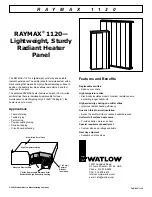
24
VENTING
PART 5: VENTING, COMBUSTION AIR & CONDENSATE REMOVAL
(CONTINUED)
8. A screened inlet air tee is provided with the water heater to be used as an outside intake
termination.
9. The following information on Table 5-8 lists optional intake air/exhaust vent terminations available
from Heat Transfer Products, Inc.
H. WATER HEATER REMOVAL FROM A COMMON VENT SYSTEM
At the time of removal of an existing water heater, the following steps shall be followed with each
appliance remaining connected to the common venting system placed in operation, while the other
appliances remaining connected to common venting system are not operating.
1. Seal any unused openings in the common venting system.
2. Visually inspect the venting system for proper size and horizontal pitch to determine if there is block-
age, leakage, corrosion or other deficiencies that could cause an unsafe condition.
3. If practical, close all building doors, windows and all doors between the space in which the
appliance remains connected to the common venting system located and other spaces in the
building. Turn on clothes dryers and any appliances not connected to the common venting system.
Turn on any exhaust fans, such as range hoods and bathroom exhausts, at maximum speed. Do
not operate a summer exhaust fan. Close all fireplace dampers.
4. Place in operation the appliance being inspected. Follow the lighting instructions. Adjust the
thermostat so the appliance will operate continuously.
5. Test for spillage at the draft hood relief opening after 5 minutes of main burner operation. Use the
flame of a match or candle or smoke from a cigarette.
6. After it has been determined that each appliance remaining connected to common venting system
properly vents when tested as outlined, return doors, windows, exhaust fans, fireplace dampers and
any other gas burning appliance to their previous condition of use.
7. Any improper operation of the common venting system should be corrected so the installation
conforms with the National Fuel Gas Code, ANSI Z223.1. When resizing any portion of the
common venting system, the common venting system should be resized to approach the
minimum size as determined using the appropriate tables in Appendix G in the National Fuel Gas
Code, ANSI Z 223.1
I. CONDENSATE REMOVAL SYSTEM
This is a condensing high efficiency appliance, therefore this unit has a condensate removal system.
Condensate is water vapor derived from the combustion products, similar to an automobile when it
is initially started. It is very important that the condensate line is sloped away from the boiler and
down to a suitable inside drain, if the condensate outlet on the water heater is lower than the drain,
you must use a condensate removal pump (kit P/N 554200 available from Heat Transfer Products,
Inc.) A condensate filter, if required by local authorities can be made up of lime crystals, marble or
phosphate chips that will neutralize the condensate. This can be done in the field by the installer or
you may purchase one from Heat Transfer Products, Inc. (P/N N1100) It is also very important that
Table 5-8: Vent Termination Kits
Description
Stock Code
2" PVC Concentric Vent Termination Kit
KGAVT0501CVT
3" PVC Concentric Vent Termination Kit
KGAVT0601CVT
2" Stainless Steel Vent Termination Kit
V500
3" Stainless Steel Vent Termination Kit
V1000
4" Stainless Steel Vent Termination Kit
V2000
Содержание Phoenix
Страница 1: ... Installation Operation Maintenance 2007 Heat Transfer Products Inc ...
Страница 31: ...30 WIRING F INTERNAL WIRING PART 6 START UP PROCEDURE CONTINUED Phoenix Connector Diagram ...
Страница 41: ...40 MAINTENANCE NOTES ...
Страница 42: ...41 MAINTENANCE NOTES ...
Страница 43: ...42 MAINTENANCE NOTES ...
Страница 44: ... 2008 2007 Heat Transfer Products Inc www htproducts com LP 179 REV 4 5 08 ...
Страница 68: ...23 ...
Страница 69: ...24 ...
Страница 73: ...28 MAINTENANCE NOTES ...
Страница 74: ...29 MAINTENANCE NOTES ...
Страница 75: ...30 MAINTENANCE NOTES ...
















































